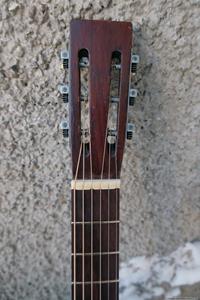The work band was sluggish during the weekends. I compiled a book of my father's memoirs and got started with my home studio and watched too much CNN and trumpageddon, but little was done anyway. Including this Old Guran from 1917.
This is not the first Levin parlor I have worked with and definitely not the last. But this one stands out. It's probably the most carelessly put together Levin parlor I've worked with so far.
The head is skewed, the missing medallion on the back of the head is still skewed. The lid had an unusual amount of run-out and was not the best wood in the factory. The simple triangular stable was twice as high as it should be (about 18 mm instead of 9 mm), probably to match a less successful neck attachment. Both lid and bottom were at least half to one mm too thick. The only thing you can not complain about is probably the page that was as it should be. But I can already reveal that the end result was very good after correcting all the mistakes (except for the crooked head which is just charming) 🙂
The most positive thing was that the thick lid had done well without major cracks, only a small chip was missing around the sound hole, otherwise the lid was without cracks and with good patina. That the lid had more run-out than usual turned out when I loosened the fretboard and stable, I pulled loose fibers on one half of the lid under both when the spatula dug itself into the fibers despite all attempts to avoid it. I had to mill and glue new wood under both the stable and the fretboard.
The neck with the oblique head was well dimensioned and in poplar wood. Not much capo had been used on it, so the back was unusually smooth. Poplar is otherwise very soft and the capos used around 1920 can sometimes give several mm deep pits on the back of the neck. Poplar is light and not stiff enough for steel strings, but together with a carbon fiber rod you get good tone and lightness from poplar and all the stiffness needed from the carbon fiber rod - a good combination. Later Levin parlor guitars after about 1920 got harder and stiffer necks in birch / maple to hold better for the steel strings. Such necks are heavier and do not sound quite as good as a poplar neck with carbon fiber rod.
Someone had worked on it before. The lid was untouched, but the walnut fingerboard had been painted black. The back and side had been sanded on and the body and neck had been repainted with spirit varnish. The paint on the side and bottom was a bit flammable due to the sanding, but luckily they had not sanded completely clean.
Fingerboard and stables were replaced with dark Madagascar rosewood (to match the black painted fingerboard). The stable was made as a slightly wider Levin pyramid stable. The simple triangular stable is not as flexible as a pyramid stable with its two thin ditches and is also heavier. To maximize the tone, the pyramid number is preferred.
A little grand of the wound in the lid under the fretboard protruded, glued in a piece of spruce from a scrapped lid with about the same color as the lid.
In order to thin down the bottom, the burner inside had to be sacrificed. I have previously made several attempts to keep a thick bottom and lid and instead make the ribbing easier, but then the guitar did not sound as good as it should when it was finished. Therefore, I now have no scruples when it comes to reducing the thickness of the lid and bottom including the burn stamp, there is hardly any doubt that it is a Levin in any case.
The bottom had cracked along the joint, but not shrunk much. To make the bottom fit against the side, I just needed to bend the side a little grand in the narrowest place. I glued the bottom halves together and glued a strip across the joint on the inside so that it would not crack again.
This one got all the options for an GammelGura, including new tuning screws and a mounted K&K mic. The measurement for intonation and neck gluing went well. It sounds at least as good as my test guitar, maybe even. better as it is very even over the entire fretboard and almost lacks the wolf tone that is always found in an acoustic guitar. Incidentally, rarely have problems with resonances on GammelGura, most likely because the stable plate in spruce and the segmented stable do not unlock the lid as much on a special frequency as a stable plate in maple and a solid stable leg in bone do. The vibration of the entire guitar for at least three days also dissolves some resonant frequencies. But this Levine was unusually smooth.
So. From being a cheap second-class Levin parlor, it is now a very good instrument to play on 🙂 We had just had the worst snowstorm when the pictures were to be taken, so it had to be a just advanced place to take the pictures.










